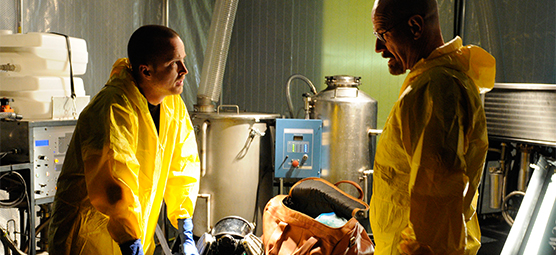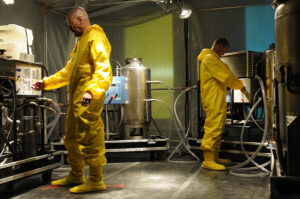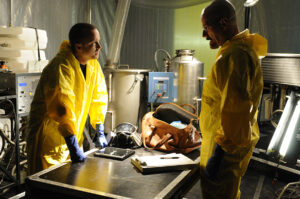“Breaking Bad” gets permanent display at Mob Museum
TV saga of schoolteacher turned drug kingpin reflects 21st century organized crime

Purchase Museum Admission
The line on which the title of Breaking Bad is based comes during the television show’s pilot episode.
Walter White, a kindly, meek and brilliant high school chemistry teacher, learns that he has terminal lung cancer. Fed up with his low-paying job, White wants to find a fast way to cover his enormous medical bills and leave a legacy for his family. He’s about to announce his desire to use his chemistry skills to cook and sell illegal methamphetamine.
On the other end of the conversation is White’s hapless, hoodie-wearing former student, the low-level drug dealer Jesse Pinkman, whose makeshift crystal meth lab in his parents’ basement was raided and destroyed.
“The DEA took all your money, your lab,” Walt tells Jesse. “You got nothin’. Square one. But you know the business, and I know the chemistry.”
Pinkman, incredulous, responds, “Some straight like you, giant stick up his ass, and all of a sudden is, what – 60? He’s just going to break bad?”
“I am awake,” replies White, soon on his way to becoming the unlikeliest of organized crime bosses.
Breaking Bad, which aired on AMC between 2008 and 2013, was critically acclaimed and beloved by cable TV audiences.

It traces Walter White’s arc as a decent, moral guy with an unfulfilled talent who evolves into a cold, vengeful, murderous drug lord nicknamed “Heisenberg.” He develops a special recipe for the highest-purity meth – 96 percent – in Albuquerque, New Mexico, and soon his product is sold throughout the American Southwest and as far away as Europe.
In recognition of Breaking Bad, a modern-day saga of organized crime, The Mob Museum debuted a permanent display of a yellow hazmat suit worn by series star Bryan Cranston — in scenes where Walter White was cooking meth — plus a pair of gas masks and a rubber apron used in the show in February of 2016.
Special guests Kathleen Detoro, costume designer for the show, and David Thomson, editor of Breaking Bad: The Official Book took part in the display unveiling at the Museum.
According to Thomson, Breaking Bad creator Vince Gilligan pictured Walter White as a professorly “Mr. Chips” who transforms into something akin to Al Pacino’s psychopathic drug chieftain in the 1983 movie Scarface.
Indeed, Breaking Bad is rife with allusions to or scenes influenced by gangster movies such as The Godfather: Part II and The French Connection, the black comedy of Fargo, Westerns such as The Great Train Robbery and the interplay of crime-boss-meets-family-drama of HBO’s The Sopranos. Among those cast in Breaking Bad are actors Steven Bauer – as Mexican drug lord Don Eladio Vuente – who previously played Pacino’s right hand Manny in Scarface, and Jonathan Banks – as ex-cop turned hitman/cleaner Mike Ehrmantraut – who starred in the 1987-90 TV drama about organized crime, Wiseguy.
Walt, the trained scientist, calls himself “Heisenberg” after the Heisenberg Uncertainly Principle by the German physicist Werner Heisenberg, who posited that the location and momentum of a nuclear particle cannot be known at the same time. For the purposes of Breaking Bad, this is taken to mean Walt’s own uncertainty of when he stops being a good, moral, family-oriented man while taking off in his role as a drug lord. When Walt dons a pork pie hat (now so famous thanks to the TV show that it’s called a “Heisenberg” hat) to serve as Heisenberg, he leaves that decent family life behind to become his criminal alter ego. His ethics are situational.
Thomson, comparing Breaking Bad to The Sopranos and the Godfather movies, describes the series as “a story about the longing of family wholeness set against violent departures from conventional morality, in which the very lives of families may be threatened (and sometimes by other family members).”
Any good drama, be it stage or screen, is driven by its characters, and Breaking Bad has a wonderfully drawn cast reacting to a succession of seemingly implausible, but rendered believable, sequences – from a giant magnet erasing evidence from a laptop stored in the Albuquerque Police evidence room to Walt dealing meth and laundering money under the nose of his own brother-in-law, a top-level DEA agent.
At the time of his fateful cancer diagnosis, Walt is living with his wife and teen son (who has a moderate case of cerebral palsy) in a modest house in suburban Albuquerque. His initial “high motivation” to sell meth is to illegally but gallantly secure lots of cash in a matter of months for his family before his inoperable cancer kills him. He figures he’ll have to “earn” $737,000, or about 11 drug deals at around $70,000 a pop, then quit. But as it happens, his cancer appears to be in remission, at least temporarily. His rationale morphs into pure selfishness beyond the money, a need for ego fulfillment to stay on as top dog in a drug underworld for its own sake, and ruthlessly eliminating those who threaten his position.
A lot about Breaking Bad concerns Walt’s hubris, his tragic flaw of pride, of being unbeatable, and lying about and rationalizing his deplorable acts to his wife, Skyler (played by Anna Gunn), to Jesse (Aaron Paul) and others. As he pointedly says in reply to Skyler, who tells him she is worried about his safety in the criminal drug business: “I am the danger. I am the one who knocks.” In another scene, he says to Pinkman: “Jesse, you asked me if I was in the meth business. … I’m in the empire business.”

Walt’s ego also remains stung by his decision as a younger man to accept a mere $5,000 for his share in a company, Gray Matter Technologies, that was created based on his original research. After he left, the company grew to be worth $2 billion and made his two former partners, now a married couple, very rich.
Throughout the series, Walt is paired with his sidekick/surrogate son Jesse, cooking up Walt’s potent, blue-colored brand of meth, for smoking or snorting by local addicts. Walt makes his first forays with the ingredients within Jesse’s shabby, 1986 Fleetwood Bounder RV parked way out in the New Mexican desert. There, clad in his white briefs and an apron, he and Jesse ready their first batches for sale on the street by Jesse’s meth-using, TV-trivia spouting crew.
Walt’s direct and indirect actions result, as some fan blogs point out, in 247 deaths, including the 167 passengers who die when airplanes crash into each other over Albuquerque. The collision happened after an air traffic controller is distracted from grief over the death of his young daughter, Jesse’s girlfriend, whom Walt could have saved from an overdose of heroin but chose not to out of fear she might lure Jesse away from their meth operation.
While deep into his empire-building, Walt pays some low-lifes to kill 11 people who are in jail but know that he is the “Heisenberg” of the local drug business. Walt himself kills other criminals by strangling, shooting, running over, blowing up or poisoning his victims to keep his cartel afloat. He even poisons the young son of Jesse’s second girlfriend in order to give Jesse the motive to turn against Walt’s former Mob boss and now enemy, Gustavo Fring (Giancarlo Esposito).
Walt and Jesse’s budding operation gains the attention of competing dealers with substandard meth. One known as Crazy 8 becomes Walt’s first kill, by asphyxiation. Crazy 8’s successor is the volatile Tuco Salamanco, played by actor Raymond Cruz, who greatly resembles Sinaloa drug lord Joaquin “El Chapo” Guzman, right down to wearing the same type of fancy shirts.
After Tuco is shot and killed by Walt’s DEA agent and brother-in-law Hank Schrader (Dean Norris), Walt is almost ready to quit while he’s ahead with just one more batch of meth. But Walt and Jessie encounter a shady lawyer named Saul Goodman (Bob Odenkirk), who sets up Walt to meet with the Albuquerque drug kingpin Fring, who agrees to buy a large amount –$1 million worth of Walt’s blue-hued drug.
It is Fring – who owns a chicken fast food chain as a front for his drug dealing – who attracts Walt into even bigger money. Fring unveils a large, new, clean meth factory the kingpin built, backed by a German company, underneath an industrial laundry facility. There, with the best equipment, Walt dons a hazmat suit and mask and methodically churns out large batches of crushed meth, stored in plastic file boxes. When Fring’s lab assistant, Gale Boetticher, appears to have learned how to cook Walt’s “Blue Sky” meth, Fring conspires to kill Walt, who instead gets a reluctant Jesse to shoot Gale dead. Walt insists to Fring that he’ll continue to cook his quality “Blue Sky” only with Jesse from now on. Fring, with the help of Jesse and Mike Ehrmantraut, kills Don Eladio Vuente and Vuente’s gang in Mexico, thus making Fring the new drug lord of the Southwest.
The ever-determined and deceptive Walt cajoles his wife Skyler (Anna Gunn) to launder his drug money through a car wash they buy. Skyler puts the piles of Walt’s currency into a storage unit. Walt’s earnings amount to $80 million. He puts the cash in barrels and buries them in the desert.
Fast forward: Walt convinces a disabled former drug mobster and enemy of Fring to be a suicide bomber, killing Fring. But it comes crashing down for Walt and Skyler. The long-clueless Hank finally figures out Walt is Heisenberg. They clash in Hank’s garage. An injured Walt, turning into Heisenberg, stiffly warns Hank that “maybe the best course would be to tread lightly,” then flees. Hank tries and fails to convince Skyler to betray Walt. Hank turns Jessie against Walt and makes Walt think they found the barrels of money. Walt takes the bait and foolishly drives to where the money is buried. Walt calls the group of low-lifes who carried out the jail killings for help, then tries to call them off after seeing that Hank and a DEA agent had followed him out there with Jesse. It’s too late. The gang kills the other agent and then shocks Walt by killing Hank. They kidnap Jesse to cook meth and leave only one barrel of money for Walt.
Now a wanted man, Walt has to go into hiding. On the phone, he tells Skyler and law enforcement where to find Hank’s body. A man known by Goodman helps Walt “disappear” into an isolated cabin in New Hampshire. But after Walt sees his rich former Gray Matter partners on TV, downplaying his contribution to the company, Walt can’t resist returning to Albuquerque to straighten them out. He convinces the partners they would be “hit” if they fail to hand over his remaining drug money to his teenage son after Walt passes. Walt secretly meets a depressed Skyler, who still faces possible charges, and tells her he didn’t do it for the family, he did because he wanted to. Then he turns his attention to saving Jesse from the low-life gang. In Scarface-like fashion, he rigs a high-caliber automatic machine gun in the trunk of his car and activates it, sending bullets into the gang’s hideout, killing nearly all of them. Walt finishes off the leader. Jesse kills his captor.
Walt, apparently wounded from shrapnel from a machine gun bullet, offers Jesse the right to shoot him, but Jesse leaves. Walt wanders out to the gang’s drug lab as police cars arrive. He gently touches a meth cooker and falls to the floor, smiling with his eyes staring upwards, to the strains of “Baby Blue,” Badfinger’s 1960s rock classic:
“Guess I got what I deserved … The special love I have for you, My Baby Blue.”
Did Walt get what he deserved? Was it all worth it? And did he really even die? Breaking Bad ends, as entertainingly as The Sopranos, with uncertainty.
Purchase Museum Admission
Feedback or questions? Email blog@themobmuseum.org





